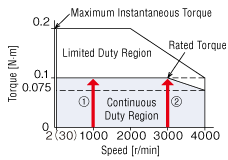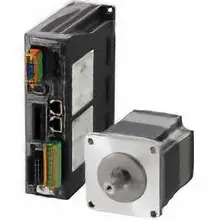Why Don't Stepper Motors Have Output Power (wattage) Indicators?


-

Vex, what are you doing staring at the general catalog?
-

Ms. Ori. Actually, a customer asked me why stepper motors don't have output (wattage) indicators. So I'm currently looking into it.

-

You've really grown, Vex, to research by yourself before asking.
-

Um...I've been looking into it, but I'm not sure... Ms. Ori, please teach me!
-

Okay, okay. Is your notepad ready? In a nutshell, the reason why stepper motors do not have an output power (W) indicator is that there is no concept of "rated speed." The output power (W) indicator of AC motors and servo motors shows the output power (W) when they are running at their "rated speed." This is called the "rated output power." The output power (W) itself can be calculated using a formula, so even with a stepper motor, it is theoretically possible to derive the output power (W) from the formula. But since stepper motors don't have the concept of "rated speed" to begin with, they can't display "rated output power," i.e., output power (W).
-

What is the formula for calculating that output power?
-

The formula for calculating the output power (W) is: Output power = rotation speed x torque x constant.
Output [W] = 0.1047 x T x N
0.1047: constant
T [N·m]: Torque
N [r/min]: Rotation SpeedWhat we mean here by "rotation speed" and "torque" is:
Rotation speed: Number of revolutions at a given point in time
Torque: Torque generated at a given point in rpm.
So, if the "rotation speed" value to be substituted is different, the calculated output (W) will also change. For example, let's calculate it in reference to the "Speed - Torque Characteristics" figure for the stepper motor RKII Series RKS566AA (refer to the figure below).- Calculated at rotation speed 1000 r/min and torque 0.5 N·m*,
0.1047 x 0.5 x 1000 = 52.3 W - Calculated at rotation speed 3000 r/min and torque 0.2 N·m*,
0.1047 x 0.2 x 3000 = 62.8 W
- *Here, the safety factor is set to about double, and the selection is made so that when the required torque is doubled, it does not exceed the pullout torque.
●Speed - Torque Characteristics of the RKS566AA 
- Calculated at rotation speed 1000 r/min and torque 0.5 N·m*,
-

Huh? Does that mean that even in the case of motors with flat torque characteristics, such as brushless motors and servo motors, the output power (W) will change if the rotation speed value to be substituted is different?
-

Right! Now let's look at the combination of the brushless motor BXII Series BXM230-A2 (motor) and the BXSD30-A2 (circuit). From the specifications in the catalog, the rated output power is 30 W, and from the "Speed - Torque Characteristics" figure, the torque is 0.1 N·m, which is the same whether the rotation speed is 1000 r/min or 3000 r/min (refer to the figure below).
●Speed - torque characteristics of the BXM230-A2 + BXSD30-A2 
- Calculated at rotation speed 1000 r/min: 0.1047 x 0.1 x 1000 ≒ 10 W,
and that's not enough for 30 W. But... - Calculated at rotation speed 3000 r/min: 0.1047 x 0.1 x 3000 ≒ 30 W,
it can result in 30 W, right?
- Calculated at rotation speed 1000 r/min: 0.1047 x 0.1 x 1000 ≒ 10 W,
-

Huh? How can a motor with flat torque characteristics change its output power depending on speed...I’m getting more confused...
-

What should we do with the numerical value substituted for this rotation speed? This is where the concept of "rated speed" comes into play. AC motors, brushless motors, and servo motors have a clear specification value called "rated speed."
- AC motor (for the 5IK40GV-JA): 1300 r/min at 50 Hz, 1550 r/min at 60 Hz
- Brushless motors: 3000 r/min (Varies with some products)
- Servo motors: 3000 r/min
The output power calculated by substituting the torque generated at the "rated speed" into the output power formula is indicated under the catalog specifications values as the "rated output power (W)."
-

I see. So that's how it works.
-

Yes. So, for customers who say, "I want to know the output power (W) of the stepper motor," you can introduce this formula as a way to calculate the output power (W) of the rotation speed they will actually use. However, even if you provisionally calculate the output power (W), if a customer tells you that "I want to switch from a servo motor with an output power of xx W to a stepper motor of equivalent output power," you need to tell them that you cannot make a comparison based on the output power (W) alone. In particular, servo motors and brushless motors have a "maximum instantaneous torque" that stepper motors do not have, so you need to be even more careful.
-

I got it. In such cases, I will first introduce the customer our motor sizing service. I want people to be able to use Oriental Motor's products for a long time without any worries.
-

That's right. I hope you will do your best so that you can suggest the best product to the customer, Vex.
- April 13, 2020 Updated with the latest information.
